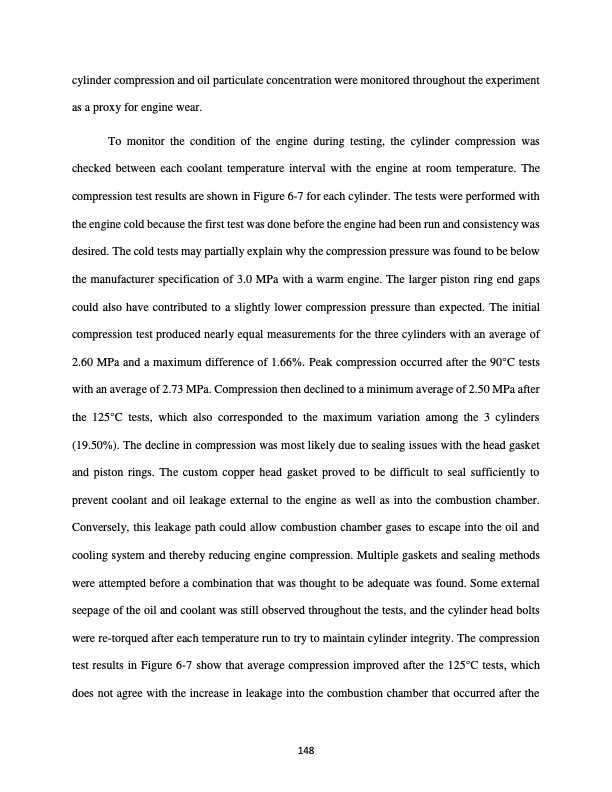
PDF Publication Title:
Text from PDF Page: 170
cylinder compression and oil particulate concentration were monitored throughout the experiment as a proxy for engine wear. To monitor the condition of the engine during testing, the cylinder compression was checked between each coolant temperature interval with the engine at room temperature. The compression test results are shown in Figure 6-7 for each cylinder. The tests were performed with the engine cold because the first test was done before the engine had been run and consistency was desired. The cold tests may partially explain why the compression pressure was found to be below the manufacturer specification of 3.0 MPa with a warm engine. The larger piston ring end gaps could also have contributed to a slightly lower compression pressure than expected. The initial compression test produced nearly equal measurements for the three cylinders with an average of 2.60 MPa and a maximum difference of 1.66%. Peak compression occurred after the 90°C tests with an average of 2.73 MPa. Compression then declined to a minimum average of 2.50 MPa after the 125°C tests, which also corresponded to the maximum variation among the 3 cylinders (19.50%). The decline in compression was most likely due to sealing issues with the head gasket and piston rings. The custom copper head gasket proved to be difficult to seal sufficiently to prevent coolant and oil leakage external to the engine as well as into the combustion chamber. Conversely, this leakage path could allow combustion chamber gases to escape into the oil and cooling system and thereby reducing engine compression. Multiple gaskets and sealing methods were attempted before a combination that was thought to be adequate was found. Some external seepage of the oil and coolant was still observed throughout the tests, and the cylinder head bolts were re-torqued after each temperature run to try to maintain cylinder integrity. The compression test results in Figure 6-7 show that average compression improved after the 125°C tests, which does not agree with the increase in leakage into the combustion chamber that occurred after the 148PDF Image | WASTE HEAT RECOVERY FROM A HIGH TEMPERATURE DIESEL ENGINE

PDF Search Title:
WASTE HEAT RECOVERY FROM A HIGH TEMPERATURE DIESEL ENGINEOriginal File Name Searched:
Adler_colostate_0053N_14539.pdfDIY PDF Search: Google It | Yahoo | Bing
NFT (Non Fungible Token): Buy our tech, design, development or system NFT and become part of our tech NFT network... More Info
IT XR Project Redstone NFT Available for Sale: NFT for high tech turbine design with one part 3D printed counter-rotating energy turbine. Be part of the future with this NFT. Can be bought and sold but only one design NFT exists. Royalties go to the developer (Infinity) to keep enhancing design and applications... More Info
Infinity Turbine IT XR Project Redstone Design: NFT for sale... NFT for high tech turbine design with one part 3D printed counter-rotating energy turbine. Includes all rights to this turbine design, including license for Fluid Handling Block I and II for the turbine assembly and housing. The NFT includes the blueprints (cad/cam), revenue streams, and all future development of the IT XR Project Redstone... More Info
Infinity Turbine ROT Radial Outflow Turbine 24 Design and Worldwide Rights: NFT for sale... NFT for the ROT 24 energy turbine. Be part of the future with this NFT. This design can be bought and sold but only one design NFT exists. You may manufacture the unit, or get the revenues from its sale from Infinity Turbine. Royalties go to the developer (Infinity) to keep enhancing design and applications... More Info
Infinity Supercritical CO2 10 Liter Extractor Design and Worldwide Rights: The Infinity Supercritical 10L CO2 extractor is for botanical oil extraction, which is rich in terpenes and can produce shelf ready full spectrum oil. With over 5 years of development, this industry leader mature extractor machine has been sold since 2015 and is part of many profitable businesses. The process can also be used for electrowinning, e-waste recycling, and lithium battery recycling, gold mining electronic wastes, precious metals. CO2 can also be used in a reverse fuel cell with nafion to make a gas-to-liquids fuel, such as methanol, ethanol and butanol or ethylene. Supercritical CO2 has also been used for treating nafion to make it more effective catalyst. This NFT is for the purchase of worldwide rights which includes the design. More Info
NFT (Non Fungible Token): Buy our tech, design, development or system NFT and become part of our tech NFT network... More Info
Infinity Turbine Products: Special for this month, any plans are $10,000 for complete Cad/Cam blueprints. License is for one build. Try before you buy a production license. May pay by Bitcoin or other Crypto. Products Page... More Info
| CONTACT TEL: 608-238-6001 Email: greg@infinityturbine.com | RSS | AMP |